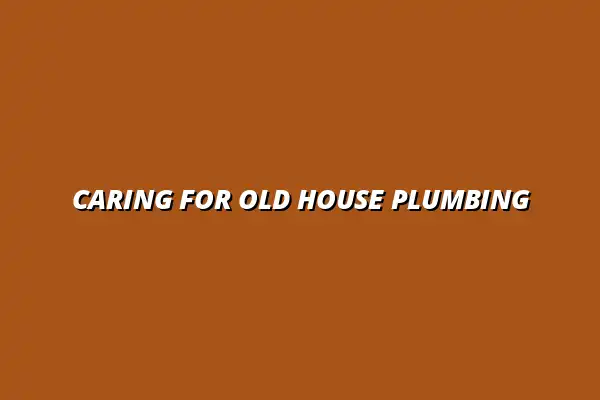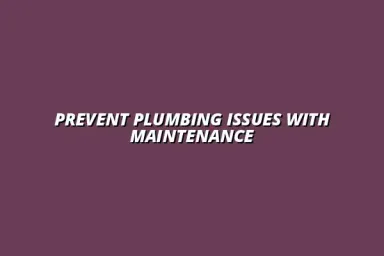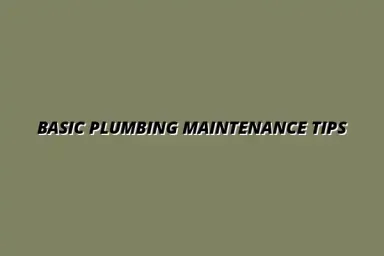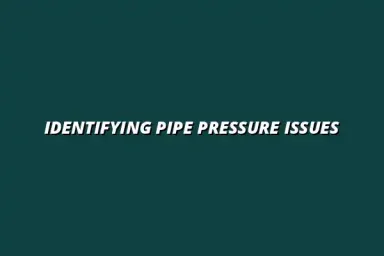Understanding the Importance of Plumbing Maintenance in Older Homes
Plumbing maintenance in older homes is crucial for ensuring the safety and comfort of your living environment. As these homes age, the plumbing systems often face unique challenges that can lead to expensive repairs if not addressed. By understanding the importance of regular maintenance, homeowners can prevent small issues from becoming larger, more costly problems.
Older homes often come with their own set of quirks and characteristics that set them apart from newer constructions. The materials used and the design of these plumbing systems can differ greatly, requiring special attention and care. With a bit of proactive maintenance, you can preserve the functionality and aesthetic charm of your historical property. For example, understanding how to prevent plumbing leaks is crucial for older homes.
Why Older Homes Require Special Attention for Plumbing
Older homes often have plumbing systems that are decades—if not centuries—old, increasing the risk of wear and tear. These systems may include outdated materials such as lead pipes or galvanized steel, which can corrode and cause health hazards. Because of this, it’s important to be vigilant and attentive to any signs of plumbing issues.
Additionally, the way plumbing was installed in older homes can vary significantly from current standards. This means that homeowners might face challenges like poor drainage or insufficient water pressure. Understanding these factors can help you take the necessary steps to maintain your plumbing effectively. For instance, learning essential plumbing maintenance techniques is a great first step.
- Lead pipes pose health risks.
- Corrosion can lead to leaks.
- Poor drainage systems may need upgrades.
The Challenges of Aging Pipes
Aging pipes can lead to a variety of problems, some of which can be severe if left unchecked. Common issues include leaks, blockages, and reduced water flow. As pipes age, they become more susceptible to damage from factors like temperature changes and corrosion.
It's essential to recognize that not all aging pipes are visible or easy to access. Many of these issues can develop within walls or underground, so regular inspections are vital. By staying ahead of potential problems, you can save yourself a lot of hassle and repair costs. Addressing frozen pipes is a common winter concern for older homes.
Common Plumbing Issues in Historical Properties
In historical properties, plumbing issues can manifest in various ways. Some typical problems include:
- Frequent clogs due to outdated piping.
- Low water pressure caused by mineral buildup.
- Leaky faucets and fixtures that are hard to replace.
Understanding these common issues can empower homeowners to be proactive. By addressing these challenges early, you can help maintain the charm and functionality of your older home. Maintaining your bathroom plumbing pipes is particularly important due to their age and potential for issues.
Essential Techniques for Maintaining Plumbing Pipes in an Old House
Maintaining plumbing pipes in an older house requires a tailored approach. Regular inspections, proper cleaning, and immediate attention to issues can go a long way in preserving your plumbing system. Let’s explore some essential techniques to keep your plumbing in excellent shape!
With the right knowledge and tools, you can effectively manage your plumbing upkeep. It's all about being aware of potential issues and knowing how to address them before they escalate. For example, knowing how to prevent bathroom sink pipe clogs can save you a lot of trouble.
Regular Inspections and Assessments of Plumbing Systems
Regular inspections are one of the most effective ways to keep your plumbing in good condition. By assessing your plumbing systems periodically, you can identify minor issues before they turn into major headaches. This proactive approach not only saves money but also extends the lifespan of your plumbing.
During inspections, look for signs of wear and tear, such as rust, leaks, or unusual noises. Taking the time to evaluate your plumbing can ensure a safe and efficient water system in your home. Remember to check your water heater as part of your regular inspection routine.
- Inspect pipes for visible leaks or corrosion.
- Check for water stains on walls and ceilings.
- Listen for unusual sounds from pipes when water flows.
Identifying Signs of Wear and Tear
Recognizing the signs of wear and tear in your plumbing is essential for effective maintenance. Some indicators include:
- Frequent backups or clogs.
- Puddles of water around fixtures.
- Changes in water color or odor.
If you notice any of these signs, it’s important to act quickly. Ignoring these issues can lead to serious damage and costly repairs down the line. If you need professional help, consider searching for a " plumber in Billesley, Birmingham".
How to Conduct a Plumbing Inspection
Conducting a plumbing inspection can be straightforward if you know what to look for. Start by checking all visible pipes for signs of leaks or corrosion. Then, test your faucets, toilets, and showerheads for any unusual behavior.
Use your senses: listen for drips, feel for dampness, and look for discoloration. If you're not comfortable conducting the inspection yourself, consider hiring a professional who specializes in plumbing maintenance for older homes.
Proper Cleaning and Care of Pipes
Keeping your plumbing pipes clean is crucial for proper functionality. Over time, debris and buildup can lead to clogs and other flow issues. Regular cleaning can help protect your plumbing system from these problems.
Different types of pipes may require different cleaning methods. It’s essential to choose the right technique to ensure you are effectively clearing any blockages without causing damage.
Effective Methods to Clear Clogs
There are several effective methods for clearing clogs in plumbing pipes:
- Using a plunger for minor blockages.
- Employing a plumber’s snake for deeper clogs.
- Pouring a mixture of vinegar and baking soda to break down buildup.
By having these tools and techniques on hand, you can address clogs promptly and prevent further issues from developing.
Choosing the Right Cleaning Products
When it comes to cleaning your plumbing, it's important to select appropriate products. Harsh chemicals can damage old pipes and create more problems. Instead, consider using environmentally-friendly options or homemade solutions.
Some safe cleaning products include:
- Vinegar and baking soda for natural cleaning.
- Liquid enzyme cleaners that are safe for pipes.
- Hot water to flush out built-up debris.
Using the right cleaning products can help you maintain a healthy plumbing system without risking damage.
Importance of Temperature Control
Temperature control is a vital aspect of maintaining plumbing in older homes. Aging pipes can be especially vulnerable to extreme temperatures, which may lead to freezing or bursting. Understanding how to manage temperature effectively is key to avoiding these issues.
Monitoring the temperature of your plumbing throughout the seasons can help protect your pipes. By taking precautions, you can extend the life of your plumbing and avoid costly repairs.
How Temperature Affects Old Plumbing
Older plumbing systems tend to be more sensitive to temperature fluctuations. For instance, during winter, pipes can freeze if the temperature drops too low. This can lead to serious damage and water loss.
Additionally, extreme heat can also affect older pipes, causing them to expand and contract. Understanding these factors is crucial in maintaining the integrity of your plumbing system.
Insulating Pipes to Prevent Freezing
Insulating your plumbing pipes is a smart way to prevent freezing during cold months. Using pipe insulation sleeves can help keep pipes warm and reduce the risk of breakage. Here are some simple steps you can take to insulate your pipes:
- Wrap exposed pipes with foam insulation sleeves.
- Seal any gaps or cracks around plumbing fixtures.
- Keep garage doors closed in colder weather to protect interior pipes.
These simple measures can make a big difference in maintaining your plumbing during the winter months.
Regular Maintenance Tasks You Shouldn't Ignore
Regular maintenance tasks are essential for ensuring your plumbing system runs smoothly. Neglecting these tasks can lead to significant problems down the line. Keeping a checklist of maintenance tasks can help you stay organized and proactive.
Here are some critical maintenance tasks that should not be overlooked:
- Checking for leaks and drips in faucets and pipes.
- Inspecting toilet performance and flushing systems.
- Monitoring water pressure and flow rates.
By paying attention to these tasks, you can help prevent major plumbing issues and keep your home running efficiently.
Checking for Leaks and Drips
Leaks and drips can lead to increased water bills and damage to your home. Check all faucets, pipes, and appliances regularly. If you notice any leaks, addressing them as soon as possible can save you time and money.
Simple things like tightening fittings or replacing washers can often resolve leaks without the need for professional help. Remember, it’s always better to act early!
Maintaining Water Pressure
Low water pressure can be a sign of underlying plumbing problems. Regularly check the flow from your faucets and showerheads. If you notice a change, it may be time to investigate further to ensure there are no blockages or leaks in your plumbing system.
By keeping an eye on your water pressure, you can catch issues early and maintain a comfortable water supply in your home.
Summarizing Key Points for Effective Plumbing Maintenance
In wrapping up our discussion on plumbing maintenance, it's crucial to highlight the key points we've covered. Regular maintenance techniques ensure that your plumbing systems remain in top shape, especially in older homes. This section will recap essential practices and underscore the need for professional support when necessary.
First and foremost, remember that regular inspections can catch issues before they escalate. Maintenance should be proactive, not reactive! By taking timely actions, you can save both time and money down the line.
Recap of Essential Plumbing Maintenance Techniques
Here’s a quick recap of the essential plumbing maintenance techniques to keep your older home running smoothly:
- Regular Inspections: Regular checks help in identifying problems early.
- Cleaning Clogs: Use effective methods to clear out blockages.
- Temperature Control: Keep an eye on temperature fluctuations to prevent pipe damage.
- Leak Checks: Regularly inspect for leaks and drips.
Each of these techniques plays a vital role in ensuring the longevity of your plumbing system. By prioritizing these tasks, you can avoid costly repairs and maintain the comfort and safety of your home.
Highlighting Regular Inspections and Repairs
Regular inspections and prompt repairs are the cornerstones of effective plumbing maintenance. A thorough inspection can reveal hidden issues, like corrosion or leaks, that may not be apparent at first glance. This proactive approach not only saves you money but also protects your home from extensive damage.
Moreover, keeping a checklist for maintenance can be incredibly useful! It ensures that nothing is overlooked and allows you to track the condition of your plumbing over time.
Emphasizing the Importance of Professional Help
While DIY methods are great, knowing when to call a professional plumber is just as important. Some plumbing issues can be complicated and require specialized tools and knowledge. A professional plumber can provide an accurate diagnosis and effective solutions.
Hiring experts when needed can save you a lot of hassle and potential expenses in the long run. They can also offer valuable advice based on their experiences, helping you avoid future problems.
Encouraging Proactive Plumbing Care
Taking care of your plumbing should be an ongoing commitment. By being proactive, you can maintain a healthy plumbing system and add to the overall value of your home. Here are some immediate steps you can take to ensure your plumbing is well cared for!
Steps to Take for Immediate Plumbing Maintenance
To get started with immediate plumbing maintenance, consider the following steps:
- Conduct a thorough inspection: Check for leaks, drips, and signs of wear.
- Clean your drains: Use safe cleaning methods to keep pipes clear.
- Monitor your water pressure: Ensure it stays within the recommended range.
- Set a regular inspection schedule: Make inspections a routine part of your home maintenance.
These simple steps can make a big difference in preventing plumbing issues. Staying on top of these tasks will keep your plumbing system running efficiently!
Creating a Plumbing Maintenance Checklist
Creating a plumbing maintenance checklist can streamline your efforts. This list should include all the critical tasks needed for your plumbing upkeep. Having a visual reminder is helpful and ensures that you don’t miss anything important.
Here are some items to include:
- Check for leaks in sinks and toilets.
- Inspect the water heater for signs of corrosion.
- Test faucets and showerheads for water pressure.
- Clear debris from drains and gutters.
By using a checklist, you can ensure that you cover all essential aspects of your plumbing maintenance, making it a routine part of your home care.
Building a Relationship with Your Local Plumber
Establishing a good relationship with a local plumber can be incredibly beneficial. They become familiar with your home’s plumbing and can offer personalized advice and service. When you call them for help, they’ll already know your system and be able to address issues more efficiently.
Regular communication with your plumber will also help you stay updated on any necessary repairs or maintenance you might need in the future. This proactive approach can prevent costly emergencies down the line!
Final Thoughts on Maintaining Plumbing Pipes in an Old House
Maintaining plumbing pipes in an older house is essential for ensuring the comfort and safety of your home. With the right techniques and regular upkeep, you can extend the life of your plumbing system. A well-maintained plumbing system not only enhances your home's functionality but can also increase its overall value!
In conclusion, I encourage homeowners to take action! Don't wait until a small problem turns into a major issue. Make plumbing maintenance a priority, and you’ll enjoy the benefits for years to come.

 Kiran Almasi
Kiran Almasi

